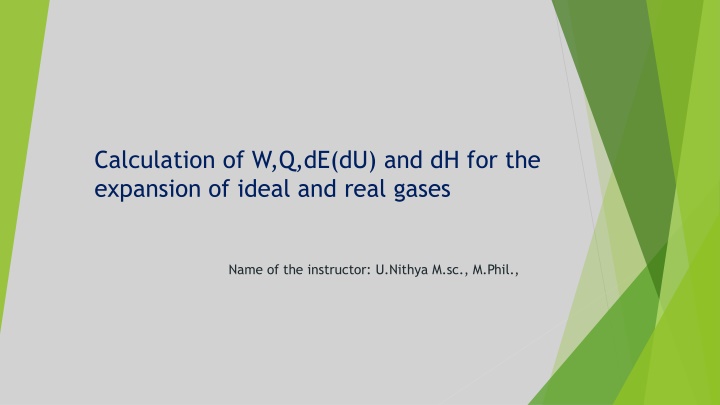
Calculation of Work, Heat, Energy, and Enthalpy Changes in Gas Expansion
Explore the calculations for work, heat, internal energy, and enthalpy changes during the expansion of ideal and real gases under isothermal and adiabatic conditions. Understand expressions and derivations for different processes, including reversible expansion of an ideal gas and changes in internal energy. Enhance your knowledge of thermodynamics with detailed explanations provided by U. Nithya.
Download Presentation

Please find below an Image/Link to download the presentation.
The content on the website is provided AS IS for your information and personal use only. It may not be sold, licensed, or shared on other websites without obtaining consent from the author. If you encounter any issues during the download, it is possible that the publisher has removed the file from their server.
You are allowed to download the files provided on this website for personal or commercial use, subject to the condition that they are used lawfully. All files are the property of their respective owners.
The content on the website is provided AS IS for your information and personal use only. It may not be sold, licensed, or shared on other websites without obtaining consent from the author.
E N D
Presentation Transcript
Calculation of W,Q,dE(dU) and dH for the expansion of ideal and real gases Name of the instructor: U.Nithya M.sc., M.Phil.,
CALCULATION OF W,Q,dE(dU) and dH for the expansion of ideal and real gases- under isothermal and adiabatic conditions for reversible process: isothermal process- temperature of the system remains constant adiabatic process no heat enters or leaves the system. Work done during isothermal changes for ideal gases:- according to first law. E =Q- W E =0. Q = W For an isothermal process heat absorbed = Work done
Work done during isothermal reversible expansion of an ideal gas: Expression: w= 2.303 nRTlog V2/V1 (or) w= 2.303 nRT log P1/P2 One mole of an ideal gas w= 2.303 RTlog V2/V1 (or) w= 2.303 RT log P1/P2 Derivation: w= Popdv reversible expansion Pop= P w = Pdv. ------------------- 1 For ideal gas PV = nRT
P=nRT/V. -------------- 2 2 in 1 w= nRT/V dv Integration of the equation w= nRT. 12 dv/v =nRT ln V2/V1 w= 2.303 nRT log V2/V1 Replacing v with RT/P w= 2.303 nRT log P1/P2
Work done during adiabatic changes for ideal gases adiabatic process Q=0 according to first law E = Q- W Q = 0 E = - W W = - E We know E = Cv T. ------------------- 1 w= - E = - Cv T ----------------- 2
Workdone during adiabatic reversible (process) expansion of an ideal gas: Expression: W=Cv(T1-T2) Derivation: first law. dE = q-w. ------------- 1 q = dE + W ----------- 2 we know. E= f (T,V) dE = ( E/ T)vdT + ( E/ V)Tdv ---------- 3 and W=PdV. -------------------- 4 4,3in 2 q = ( E/ T)vdT + ( E/ v) dv + Pdv ---------- 5 Adiabatic change q=o, ideal gas ( E/ v)T=0 0 = ( E/ T)vdT+0+Pdv ----------------------- 6
By definition ( E/ T)v= Cv------------------------ 7 7in 6 0 = CvdT + 0 +Pdv Pdv. = - CvdT Expansion W= 12 Pdv = - 12 CvdT = - Cv(T2-T1) W = Cv(T1-T2)
Change in internal energy (E) during isothermal changes for ideal gas: E:- T,E is a constant,it is independent of volume ( E/ V)Tdv. = 0 ( E)T,V =0 H:- H=E+PV H = E + (PV) -------------------- 1 ideal gas PV = nRT. --------------- 2 2 in 1 H = E + nRT. --------------- 3 E = 0, T= 0, H =0
To show that (H/P)T = 0 H=E+PV PV=RT H=E+RT ------------------------ 1 Differentiate 1 with respect to pressure at constant temp ( H/ P)T= ( E/ P)T+0 we know ( E/ P)T=0, ( H/ P)T= 0
Change in internal energy(E) during adiabatic changes for ideal gases: Q=0 First law. E = Q-W E = -W - E = W W = +ve. E = -ve W = -ve. E = +ve E : ( E/ T)v= Cv dE = CvdT E = Cv T
H: H= E +PV H = E + PV PV = nRT. For one mole PV = RT H = E + R T. ----------------- 1 E. = Cv T. ------------------ 2 2 in 1 H = Cv T + R T H = (Cv+R) T. ------------------ 3 Cp- Cv = R, Cp= Cv + R. ---------------- 4 sub 4. in. 3 H = Cp T






















